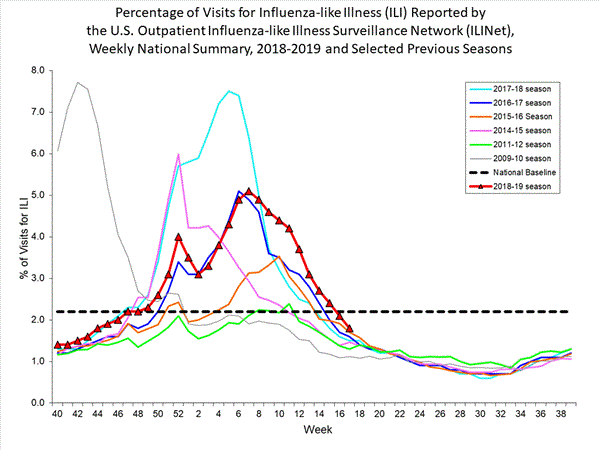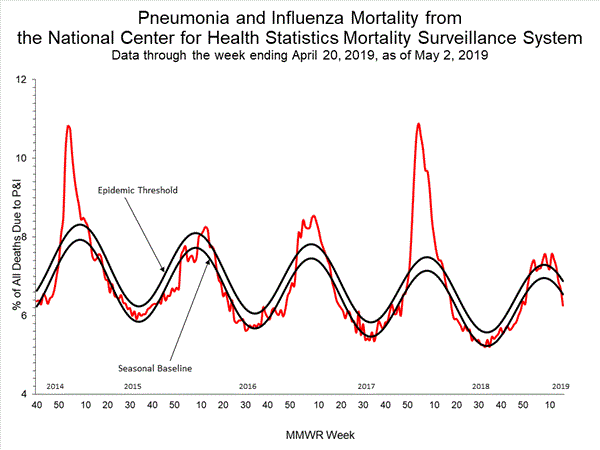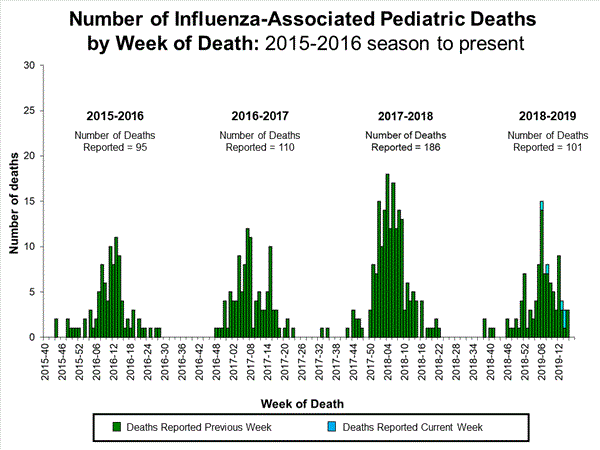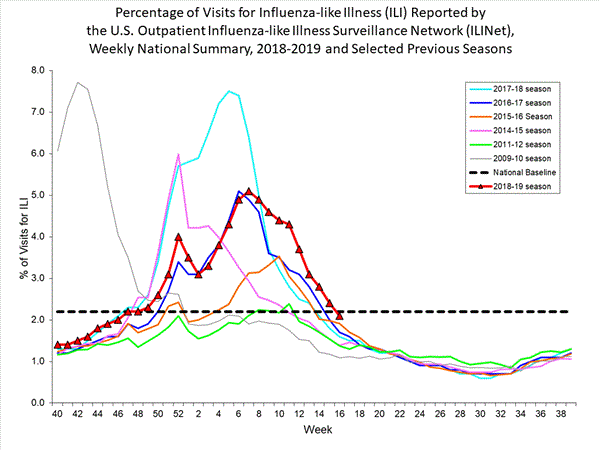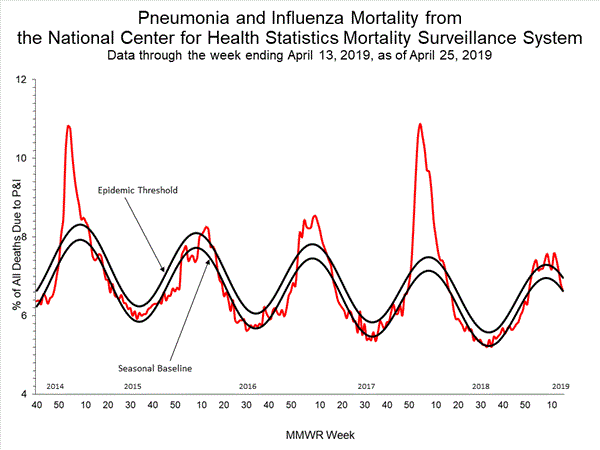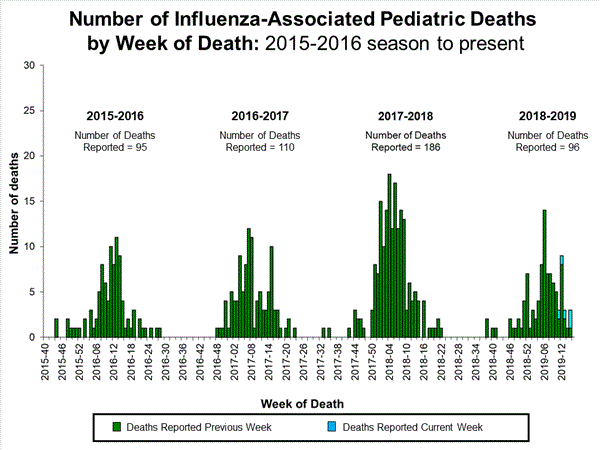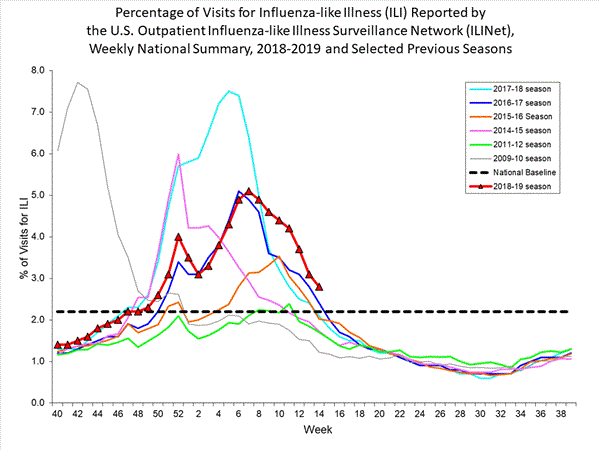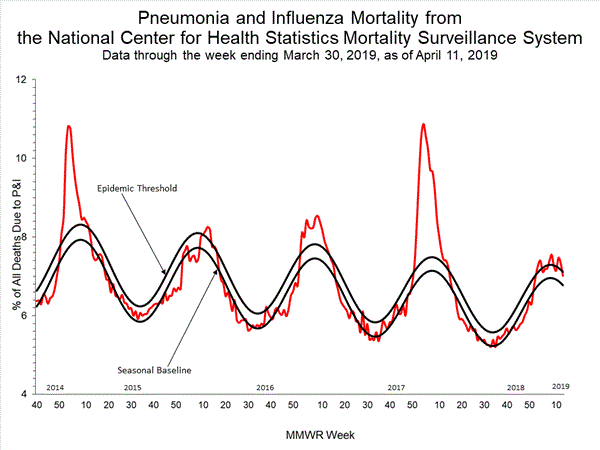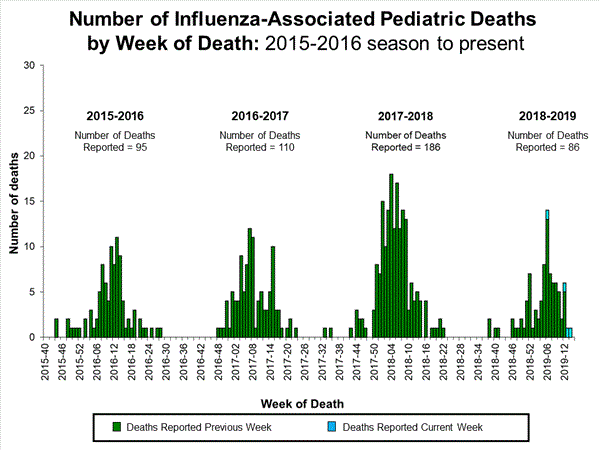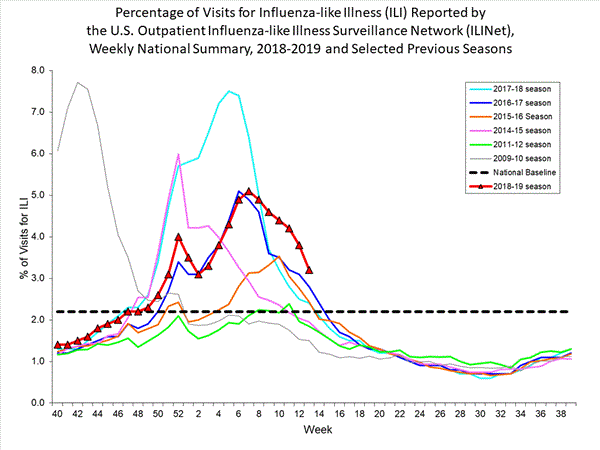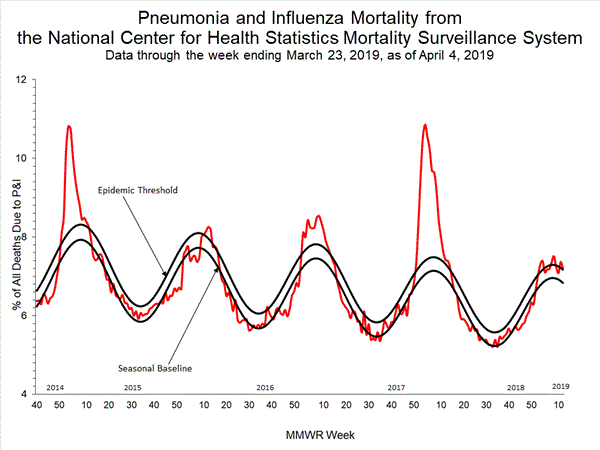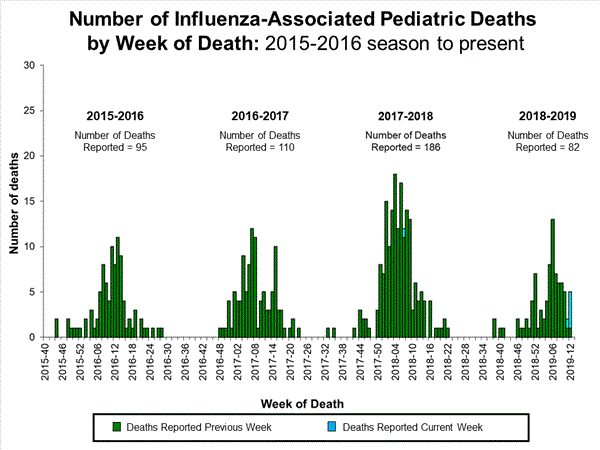Archive for the ‘Influenza’ Category
2018-2019 U.S. Flu Season: Preliminary Burden Estimates
Saturday, April 13th, 2019![]()
34.9 million – 40.1 million
flu illnesses
16.1 million – 18.8 million
flu medical visits
482,000 – 585,000
flu hospitalizations
32,900 – 54,800
flu deaths
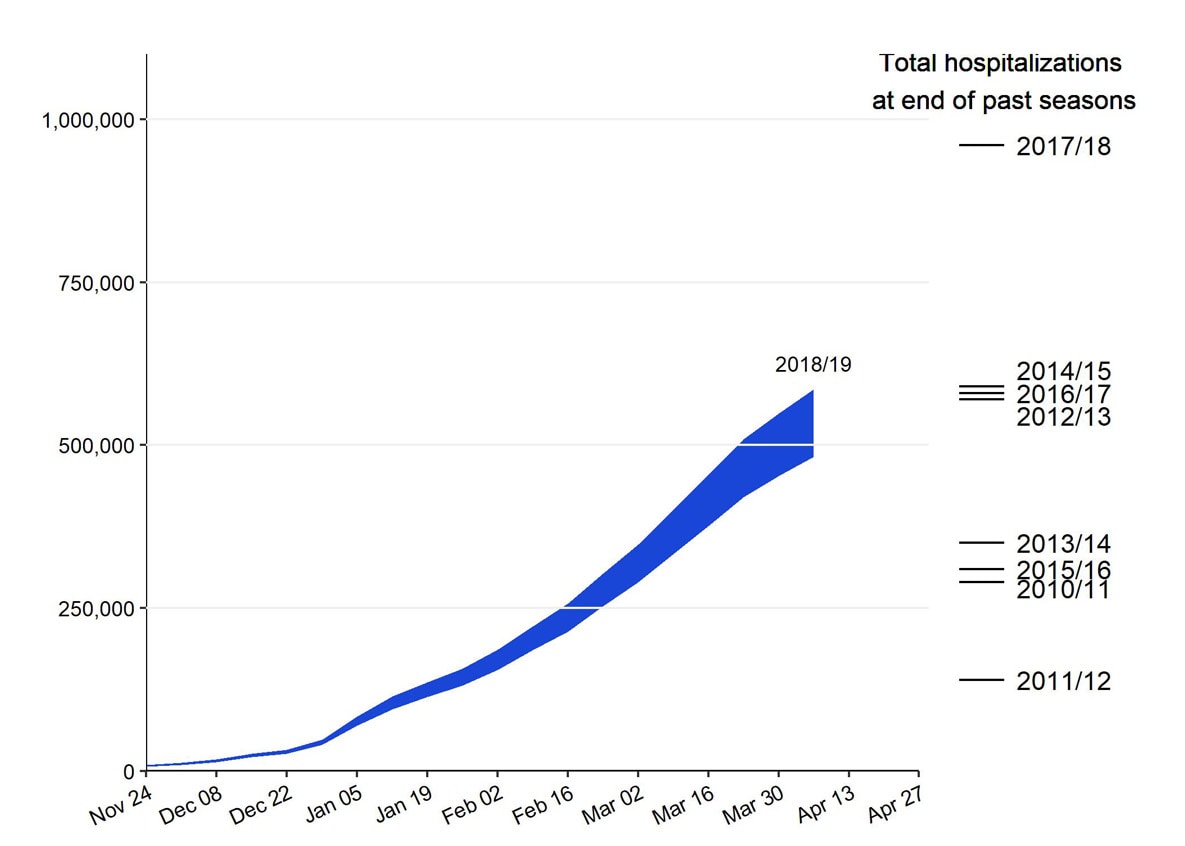
Ready or Not: Protecting the Public’s Health from Diseases, Disasters and Bioterrorism, 2019
Tuesday, April 9th, 2019“One lesson from recent events is that emergencies happen. And happen often. From disease outbreaks to natural disasters to man-made crises, the stakes are high: Americans face serious health risks and even death with increasing regularity. Therefore, as a nation, it’s critical to ask, “Are we prepared?”
Executive Summary
The public health emergencies of the past year—an unusually severe flu season, confounding cases of acute flaccid myelitis, two major hurricanes, and the deadliest fire season in California’s history reinforce the need for every jurisdiction to be vigilant about preparing for emergencies in order to safeguard the public’s health.
A fundamental role of the public health community is to protect communities from disasters and disease outbreaks. To this end, the nation’s health security infrastructure has made tremendous strides since 2001 by building modern laboratories, maintaining a pipeline of medical countermeasures, and recruiting and retaining a workforce trained in emergency operations. Yet, unstable and insufficient funding puts this progress at risk, and a familiar pattern takes shape: underfunding, followed by a disaster or outbreak, then an infusion of onetime supplemental funds, and finally a retrenchment of money once attention wanes. What’s more, states are uneven in their levels of preparedness. Some—often those that most frequently face emergencies—have the personnel, systems, and resources needed to protect the public. But others are less prepared and less experienced, elevating the likelihood of preventable harms. This unstable funding and uneven preparation undermines America’s health security.
The Ready or Not: Protecting the Public’s Health from Diseases, Disasters and Bioterrorism series, produced by Trust for America’s Health (TFAH), has tracked public health emergency preparedness in the United States since 2003. The series has documented significant progress in the nation’s level of preparedness as well as those areas still in need of improvement.
Ready or Not examines the country’s level of public health emergency preparedness on a state-by-state basis using 10 priority indicators. (See Table 1.) Taken together, the indicators are a checklist of priority aspects of states’ readiness for public health emergencies. However, these indicators do not necessarily reflect the effectiveness of states’ public health departments. Improvement in these priority areas often requires action from other agencies, elected officials or the private sector.
The 2019 report finds that states have made progress in key areas, including public health funding and participation in provider compacts and coalitions. However, performance in other areas—such as flu vaccination, hospital patient safety, and paid time off for workers—has stalled or lost ground.
Table 1: Top-Priority Indicators of State Public Health Preparedness
| Indicators | |||
| 1 | Incident Management: Adoption of the Nurse Licensure Compact. | 6 | Water Security: Percentage of the population who used a community water system that failed to meet all applicable health-based standards. |
| 2 | Cross-Sector Community Collaboration: Percentage of hospitals participating in healthcare coalitions. | 7 | Workforce Resiliency and Infection Control: Percentage of employed population with paid time off. |
| 3 | Institutional Quality: Accreditation by the Public Health Accreditation Board. | 8 | Countermeasure Utilization: Percentage of people ages 6 months or older who received a seasonal flu vaccination. |
| 4 | Institutional Quality: Accreditation by the Emergency Management Accreditation Program. | 9 | Patient Safety: Percentage of hospitals with a top-quality ranking (Grade A) on the Leapfrog Hospital Safety Grade. |
| 5 | Institutional Quality: Size of the state public health budget, compared with the past year. | 10 | Health Security Surveillance: The public health laboratory has a plan for a six- to eight-week surge in testing capacity. |
Notes: The National Council of State Boards of Nursing organizes the Nurse Licensure Compact. The federal Hospital Preparedness Program of the U.S. Office of the Assistant Secretary for Preparedness and Response supports healthcare coalitions. The U.S. Environmental Protection Agency assesses community water systems. Paid time off includes sick leave, vacation time, or holidays, among other types of leave. The Leapfrog Group is an independent nonprofit organization. Every indicator, and some categorical descriptions, were drawn from the NHSPI, with one exception: public health funding. See “Appendix A: Methodology” for a description of TFAH’s funding data-collection process, including its definition.
Source: National Health Security Preparedness Index.
For the first time, Ready or Not groups states and the District of Columbia into one of three tiers based on their performance across the 10 indicators. This year, 17 states scored in the top tier, 20 and the District of Columbia placed in the middle tier, and 13 were in the bottom tier. (See Table 2).
By gathering together timely data on all 50 states and the District of Columbia, the report assists states in benchmarking their performance against comparable jurisdictions. To help states track their own progress, TFAH will strive to maintain continuity among the indicators tracked in this edition of the report for the next several years.
Table 2: State Public Health Emergency Preparedness
State performance, by scoring tier, 2018
| Performance Tier | States | Number of States |
| Top Tier | AL, CO, CT, FL, ID, KS, MA, MD, MO, MS, NC, NE, NJ, RI, VA, WA, WI | 17 states |
| Middle Tier | CA, DC, GA, HI, IA, IL, LA, ME, MI, MN, MT, ND, NH, NM, NV, OK, OR, SC, TX, VT, WV | 20 states and DC |
| Bottom Tier | AK, AR, AZ, DE, IN, KY, NY, OH, PA, SD, TN, UT, WY | 13 states |
Report Findings
A majority of states have made preparations to expand capabilities in an emergency, often through collaboration. In 2018, 31 states participated in the Nurse Licensure Compact, which allows registered nurses and licensed practical or vocational nurses to practice in multiple jurisdictions with a single license. In an emergency, this enables health officials to quickly increase their staffing levels. For example, nurses may cross state lines to lend their support at evacuation sites or other healthcare facilities. The number of states participating in the compact is up by five from 26 in 2017.
In addition, hospitals in most states have a high degree of participation in healthcare coalitions. On average, 89 percent of hospitals were in a coalition and 18 states had universal coalition participation, meaning every hospital in the state was part of a coalition. Such coalitions bring hospitals and other healthcare facilities together with emergency management and public health officials to plan for, and respond to, events requiring extraordinary action. This increases the likelihood that patients are served in a coordinated and efficient manner during an emergency.
Finally, 44 states and the District of Columbia had a plan to surge public health laboratory capacity for six to eight weeks as necessary during overlapping emergencies or large outbreaks.
Most residents who got their household water through a community water system had access to safe water. On average, just 6 percent of state residents used a community water system in 2017 that did not meet all applicable health-based standards. Water systems with such violations increase the chances of water-based emergencies in which contaminated water supplies place the public at risk.
Most states are accredited in the areas of public health, emergency management, or both. In 2018, the Public Health Accreditation Board or the Emergency Management Accreditation Program accredited 42 states and the District of Columbia; 26 states were accredited by both groups. Eight states (Alaska, Hawaii, Indiana, New Hampshire, South Dakota, Texas, West Virginia, and Wyoming) were accredited by neither. Both programs help ensure that necessary emergency prevention and response systems are in place and staffed by qualified personnel.
Seasonal flu vaccination rate, already too low, fell further. The seasonal flu vaccination rate among Americans ages 6 months or older dropped from 47 percent in the 2016–2017 season to 42 percent in the 2017–2018 season. This drop-in coverage may have exacerbated the severity of the 2017-2018 influenza season and the high number of illnesses, hospitalizations and deaths due to flu. Healthy People 2020, a set of federal 10-year objectives and benchmarks for improving the health of all Americans by 2020, set a seasonal influenza vaccination-rate target of 70 percent annually.
In 2018, only 55 percent of employed state residents, on average, had access to paid time off. Those without such leave are more likely to work when they are sick and risk spreading infection. In the past, some infectious disease outbreaks have been linked to or exacerbated by the absence of paid sick leave.
Only 28 percent of hospitals, on average, earned a top-quality patient safety grade. Hospital safety scores measure performance on such issues as healthcare-associated infection rates, intensive-care capacity, nursing staff volume, and an overall culture of error prevention. In the absence of diligent actions to protect patient safety, deadly infectious diseases can take hold or strengthen.
Climate Change Increases Likelihood of Extreme Weather
According to the Center for Climate and Energy Solutions, a nonprofit advocacy group, climate change is expected to increase the frequency, intensity, and consequences of some types of extreme weather events, including:
- Drought, which can contribute to food insecurity and exacerbate wildfires.
- Extreme heat, which in a typical year already kills more people in the United States than hurricanes, lightning, tornadoes, earthquakes, and floods combined. Extreme heat is especially dangerous for medically vulnerable people. It also worsens droughts and increases the risk of wildfires.
- Heavy rains, which cause catastrophic flooding, landslides, and contaminated waterways.
- Hurricanes, which sometimes have more destructive wind speeds, precipitation, and storm surges.
- Wildfires, which can now burn more land and are more difficult to extinguish.
In 2017 alone, at least 15 extreme weather events across the globe were made more likely by climate change, according to studies published by the American Meteorological Society.
On top of possible federal action, states and localities can act to mitigate these threats, particularly the dangers they pose to people with health ailments or in poor living conditions. For example, land-use planning can reduce loss of life and property from wildfires. Zoning rules that limit building in flood-prone areas reduces the dangers from floods, and replacing nonpermeable surfaces with “green infrastructure,” such as rain gardens and bioswales, reduces stormwater runoff and subsequent flooding. In drought-prone areas, green infrastructure can retain stormwater for later use. Cooling centers can keep vulnerable populations safe during heat waves, and green roofs can reduce the urban heat island effect. Finally, preserving coastal wetlands, dunes, and reefs can help absorb storm surges from hurricanes.
Report Recommendations
There are a host of concrete actions to further protect the public’s health that TFAH recommends be taken by federal, state, and local officials; the healthcare system; academia; and the private or nongovernmental sectors.
Those that are of highest priority include:
- Providing stable, dedicated, and sufficient funding for preparedness activities and a significant funding increase for core public health capabilities.
- Establishing a complementary emergency response fund to accelerate crisis responses.
- Maintaining a long-term investment in the Global Health Security Agenda framework and global preparedness and response programs to help prevent infectious disease threats from becoming global crises.
- Fully implementing the National Biodefense Strategy including with transparent goals, implementation plans, and budgets for all relevant agencies.
- Monitoring and addressing any potential challenges caused by the transition of the Strategic National Stockpile and significantly strengthening the “last mile” of distribution and dispensing.
- Developing a multiyear strategic vision, and fully funding surveillance infrastructure, for fast, accurate outbreak detection at all levels of government.
- Bolstering the Hospital Preparedness Program and multisector healthcare collaboration as well as adopting state policies to improve healthcare delivery during disasters.
- Adopting comprehensive climate change adaptation plans, including a public health assessment and response.
- Increasing public and private investments in efforts to combat antimicrobial resistance, including through diagnostic, stewardship, detection, and treatment methods.
- Supporting vaccine infrastructure and first-dollar coverage of recommended vaccines.
- Promoting health equity in emergency preparedness planning, response, and recovery, including through the appointment of a chief equity or resilience officer.
Taken together, action on TFAH’s recommendations would make the United States safer for all its residents.
2018-2019 Influenza Season Week 13 ending March 30, 2019: Influenza activity decreased but remains elevated in the United States.
Sunday, April 7th, 2019H1ssF_3928: The universal flu vaccine?
Sunday, April 7th, 2019“The first clinical trial of an innovative universal influenza vaccine candidate is examining the vaccine’s safety and tolerability as well as its ability to induce an immune response in healthy volunteers. Scientists at the National Institute of Allergy and Infectious Diseases (NIAID), part of the National Institutes of Health, developed the experimental vaccine, known as H1ssF_3928.
H1ssF_3928 is designed to teach the body to make protective immune responses against diverse influenza subtypes by focusing the immune system on a portion of the virus that varies relatively little from strain to strain. ….

The clinical trial is being conducted at the NIH Clinical Center in Bethesda, Maryland. It is being led by Grace Chen, M.D., of NIAID’s Vaccine Research Center (VRC) Clinical Trials Program. The trial will gradually enroll at least 53 healthy adults aged 18 to 70 years. The first five participants will be aged 18 to 40 years and will receive a single 20-microgram (mcg) intramuscular injection of the experimental vaccine. The remaining 48 participants will receive two 60-mcg vaccinations spaced 16 weeks apart. They will be stratified by age into four groups of 12 people each: 18 to 40 years, 41 to 49 years, 50 to 59 years, and 60 to 70 years. Investigators hope to understand how participants’ immune responses to the experimental vaccine may vary based on age and the likelihood of their previous exposure to different influenza variants.
Study participants will be asked to record their temperature and any symptoms on a diary card for one week after each injection. They also will be asked to visit the clinic to provide blood samples at various time points. Investigators will test the samples in the laboratory to characterize and measure levels of anti-influenza antibodies, which are potentially indicative of immunity against influenza. Participants will return for nine to 11 follow-up visits over 12 to 15 months. They will not be exposed to any influenza virus as part of the clinical trial…..”
CDC: People at High Risk of Developing Serious Flu–Related Complications
Sunday, April 7th, 2019People at High Risk of Developing Flu-Related Complications
- Children younger than 5, but especially children younger than 2 years old
- Adults 65 years of age and older
- Pregnant women (and women up to two weeks postpartum)
- Residents of nursing homes and other long-term care facilities
- Also, American Indians and Alaska Natives[1.1 MB, 2 pages] seem to be at higher risk of flu complications
People who have medical conditions including:
- Asthma
- Neurological and neurodevelopmental conditions (including disorders of the brain, spinal cord, peripheral nerve, and muscle such as cerebral palsy, epilepsy [seizure disorders], stroke, intellectual disability, moderate to severe developmental delay, muscular dystrophy, or spinal cord injury)
- Chronic lung disease (such as chronic obstructive pulmonary disease [COPD] and cystic fibrosis)
- Heart disease (such as congenital heart disease, congestive heart failure and coronary artery disease)
- Blood disorders (such as sickle cell disease)
- Endocrine disorders (such as diabetes)
- Kidney disorders
- Liver disorders
- Metabolic disorders (such as inherited metabolic disorders and mitochondrial disorders)
- Weakened immune system due to disease or medication (such as people with HIV or AIDS, or cancer, or those on chronic steroids)
- People younger than 19 years of age who are receiving long-term aspirin therapy
- People with extreme obesity (body mass index [BMI] of 40 or more) Calculate your Body Mass Index or BMI
Preliminary Burden Estimates: CDC estimates that, from October 1, 2018, through March 30, 2019, there have been:
Saturday, April 6th, 2019
flu illnesses
15.3 million – 17.8 million
flu medical visits
452,000 – 549,000
flu hospitalizations
30,600 – 50,900
flu deaths
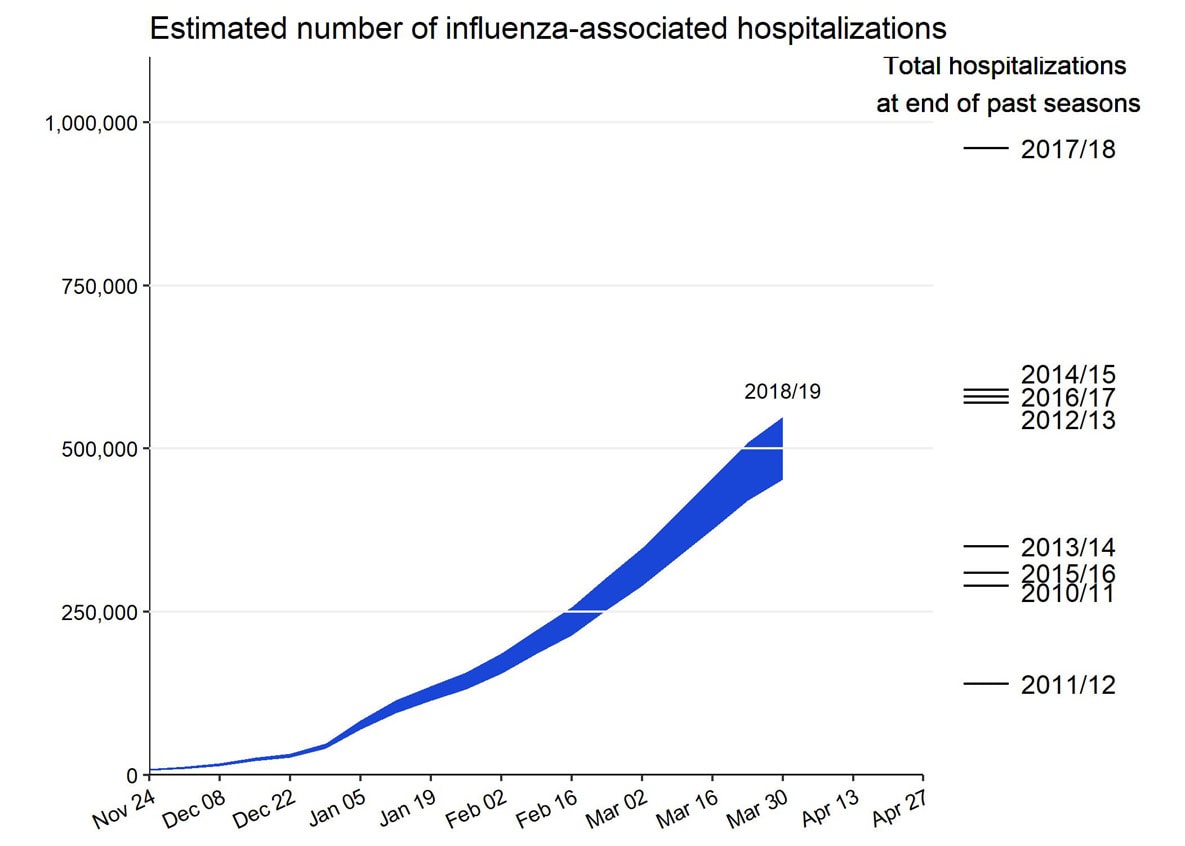
HHS: A Global Response to a Global Threat
Monday, April 1st, 2019The very word ‘pandemic’ conjures images of global disease and death. Educational campaigns highlighting the centennial of the 1918 Influenza pandemic are a jarring reminder that more than 50 million people died due to a previously unknown influenza strain against which very few people had immunity. However, few people today understand that every year over one billion people worldwide are infected by seasonal influenza viruses resulting in as many as 650,000 deaths. This global threat requires a global response.

On Monday, March 11th the World Health Organization (WHO) released the Global Influenza Strategy 2019-2030 – PDF . The Strategy signifies a holistic effort to strengthen national capacities to detect, prevent, and respond to seasonal and pandemic influenzas on a global scale, and to capitalize on recent influenza preparedness gains. The new strategy strengthens our work with WHO to fight influenza and prevent or slow any worldwide outbreak of the viral disease. This plan leverages expertise from across HHS, including the U.S. Food and Drug Administration, the National Institutes of Health, the Office of the Assistant Secretary for Preparedness and Response, Centers for Disease Control and Prevention and the Office of Global Affairs. Our proven domestic preparedness efforts coupled with a more seamless and global commitment will help quickly combat the most dangerous and persistent infectious disease threats.
Last year in the U.S., there were 49 million influenza infections, 960,000 hospitalizations, and 79,000 deaths, despite the availability of a seasonal vaccine. Influenza vaccination prevented approximately seven million illnesses, and 8,000 deaths during the 2017-2018 U.S. flu season. The yearly occurrence of seasonal influenza oftentimes means that this disease is not taken seriously, but complacency should never undermine our vigilance in prevention efforts. Continued innovation in our domestic medical countermeasures, surveillance and response capabilities as well as increased public awareness about the importance of vaccines are essential in the fight against seasonal influenza and another global pandemic.
The launch of the WHO Strategy builds upon its nearly 80-year history in seasonal and pandemic influenza preparedness. It sets forth a vision aimed at providing nations, industry, and civil society with a framework allowing better global influenza surveillance, disease prevention and control. It sharpens countries’ preparedness efforts, and promotes basic and applied research that will produce better diagnostics, antivirals, and vaccines.
In an increasingly mobile society, this global strategy is more important than ever. Pathogens do not respect borders; all it takes is a plane ticket to transport these invisible germs around the world in hours. The US must lead by example, our domestic disease prevention efforts are a model for the rest of the world. International collaboration is the only way to prevent mobile viruses from quickly spreading.
The U.S. Centers for Disease Control and Prevention (CDC) is one of the six premier WHO Influenza Collaborating Centers monitoring the evolution and emergence of influenza viruses. CDC provides data and recommendations for diagnostics, vaccines, antiviral drugs, and risk assessment that directly inform our global preparedness in addition to preparing candidate vaccine viruses for use in vaccine production. CDC also works with more than 50 nations to enhance their capacity to detect, prevent and respond to both seasonal and pandemic influenza. These collaborations lead to sharing information between nations, including knowledge of outbreaks of novel virus detections, and lead to earlier prevention and control at home and abroad. Combating influenza is not done in a vacuum; all nations must work together.

In 2006, WHO created the Global Action Plan for influenza vaccines (GAP) . With the technical expertise of HHS’s Biomedical Advanced Research and Development Authority (BARDA), the plan introduced influenza vaccine manufacturing to areas of the world where none or very few vaccines existed. One of the program’s many success stories is the Institute of Vaccines and Medical Biologicals (IVAC) in Vietnam. Just this year, IVAC licensed its first seasonal trivalent influenza vaccine. Vietnam now has the ability to provide influenza vaccines to the people of Vietnam and help the global community with surveillance and manufacturing. The 15 companies, from 13 low and middle income countries, supported by BARDA and WHO in this program expanded their pandemic influenza vaccine production capacity from less than 1 million doses in 2006 to over 600 million doses in 2018. Since its creation, GAP has contributed to an increased global vaccine capacity from an estimated 500 million doses in 2006, to a predicted ability to produce over six billion doses for the next influenza pandemic. This is a major global preparedness milestone. Domestically, ASPR/BARDA is also working with industry to improve seasonal and pandemic influenza vaccines by utilizing new technology to improve production methods that reduce the time needed to produce and administer vaccines in response to a pandemic.
HHS has other major initiatives dedicated to understanding and improving influenza preparedness, surveillance, and response. The National Institutes of Health’s (NIH) National Institute of Allergy and Infectious Disease is involved with innovative work investigating universal influenza vaccines and next generation diagnostics, antiviral agents and other research that provides valuable information about the influenza virus and host response. Much of this research is generated by NIAID’s network of Centers for Excellence for Influenza Research and Surveillance (CEIRS).
The Food and Drug Administration (FDA) is an Essential Regulatory Laboratory within the WHO system and works directly with key partner nations to strengthen regulatory systems that support influenza vaccine manufacturing capacity through WHO’s GAP program. In collaboration with other Essential Regulatory Laboratories in the United Kingdom, Australia, and Japan, FDA contributes to a range of activities each year for the production of influenza vaccines, including strain selection for seasonal and pandemic influenza vaccines, preparing virus stocks, and calibrating vaccine reagents.
HHS will continue to work every day to prevent and contain the threat of disease. We are a committed partner in the WHO Global Influenza Strategy. We collaborate with academia and the private sector to advance influenza preparedness. Influenza is an international problem that necessitates global collaboration and an infrastructure ready for worldwide response. We are proud that HHS is working hand in hand with WHO to lead global efforts to prevent the next pandemic.
Garrett Grigsby is the Director of the HHS Office of Global Affairs and Dr. Robert Kadlec is the Assistant Secretary of Preparedness and Response.


